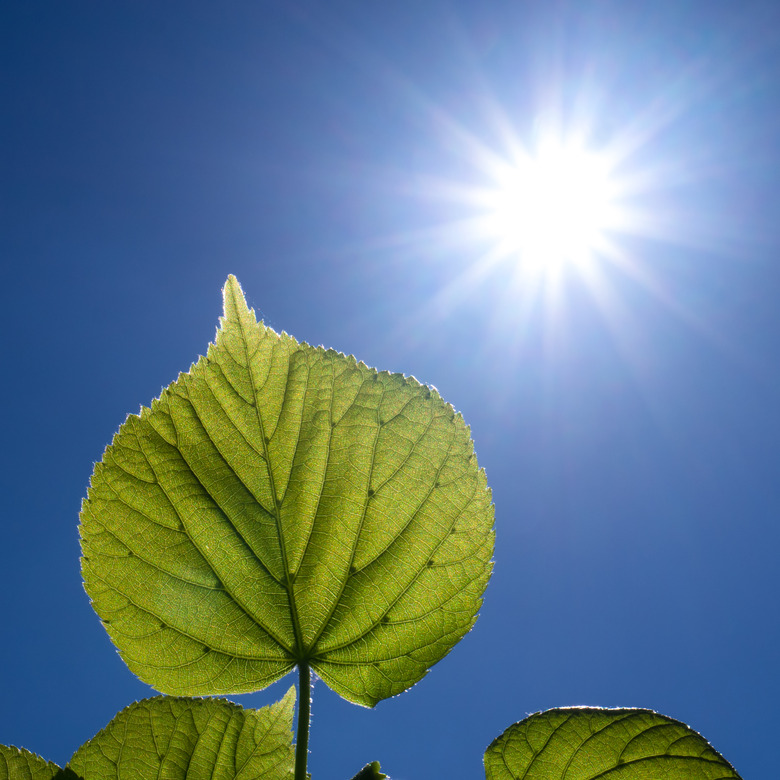The Differences Between Photosynthesis & Respiration
Photosynthesis is the process used by plants and some bacteria to create energy from sunlight. Chlorophyll is the green pigment in plants that is responsible for this conversion process. In all other living things, they rely on the process of respiration to stay alive. Respiration is the process of taking oxygen from the air and cycling it through the lungs, which then gives oxygen to blood to be used in the body. The carbon dioxide waste is expelled out of the lungs. Cellular respiration uses glucose, or sugars, from food molecules and turns them into carbon dioxide, water, and ATP a nucleotide essential to the body.
Photosynthesis
Photosynthesis
Photosynthesis converts light energy into chemical energy, and stores it in sugar. This process occurs in the chloroplasts, using chlorophyll. The chemical formula for the process requires six molecules of carbon dioxide and six molecules of water plus the energy from light. This creates a sugar chain and six units of oxygen. Chlorophyll is green because the light required for photosynthesis is red and blue light, leaving green light to be reflected back to our eyes.
Plants
Plants
Photosynthesis occurs in the leaves of plants with little to none in the stems. Plant leaves are made of upper and lower epidermises, mesophyll, veins, and stomates. Mesophyll is the layer of the plant that contains chloroplasts and is the only place photosynthesis occurs. The energy taken is stored as ATP (adenosine triphosphate). It is required for energy storage and is made of the nucleotide adenine with ribose sugar.
Respiration
Respiration
The respiratory system allows living creatures that are not plants to obtain oxygen from the air for use in the blood and cells. Oxygen is a much needed nutrient and living organisms can roughly only survive for minutes without it. Even if oxygen flow is reestablished, the damage can be irreparable. Alveoli are responsible for exchanging oxygen rich air with carbon dioxide rich blood cells. Diffusion occurs due to the pressure difference between alveoli, which is high, and the pressure of blood, which is lower. Blood cells take the oxygen and alveoli take the carbon dioxide, which is then exhaled.
Cellular Respiration
Cellular Respiration
Cellular respiration first breaks down glucose into pyruvic acid, and then the pyruvic acid is oxidized into carbon dioxide and water. This process usually occurs in the cytosol and mitochondria of eukaryotic cells. Mitochondria are organelles responsible for the conversion of potential energy into ATP.
Difference
Difference
The main difference between photosynthesis and respiration is where it occurs, one being in plants and some bacteria and the other being in most every other living thing. The other difference is that plants require sunlight for the process to occur, whereas respiration does not. But there is an important mutual relationship between the two processes because of the ingredients required, and bi-products produced. If plants take carbon dioxide and expel oxygen, and most other living things take in oxygen and expel carbon dioxide, the importance of both systems working in unison is obvious.
References
Cite This Article
MLA
Kennedy, David. "The Differences Between Photosynthesis & Respiration" sciencing.com, https://www.sciencing.com/differences-between-photosynthesis-respiration-5132802/. 24 April 2019.
APA
Kennedy, David. (2019, April 24). The Differences Between Photosynthesis & Respiration. sciencing.com. Retrieved from https://www.sciencing.com/differences-between-photosynthesis-respiration-5132802/
Chicago
Kennedy, David. The Differences Between Photosynthesis & Respiration last modified March 24, 2022. https://www.sciencing.com/differences-between-photosynthesis-respiration-5132802/
